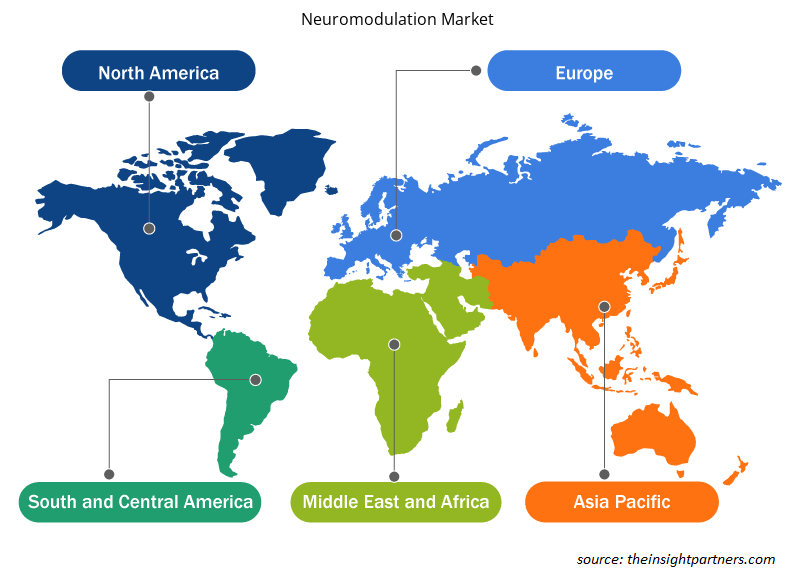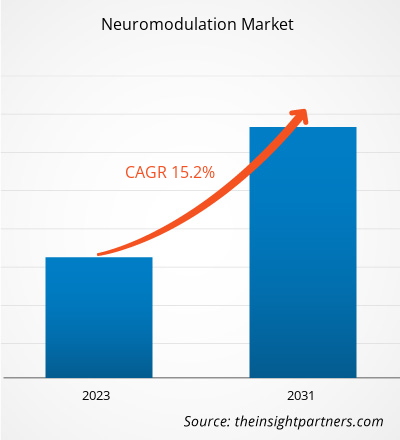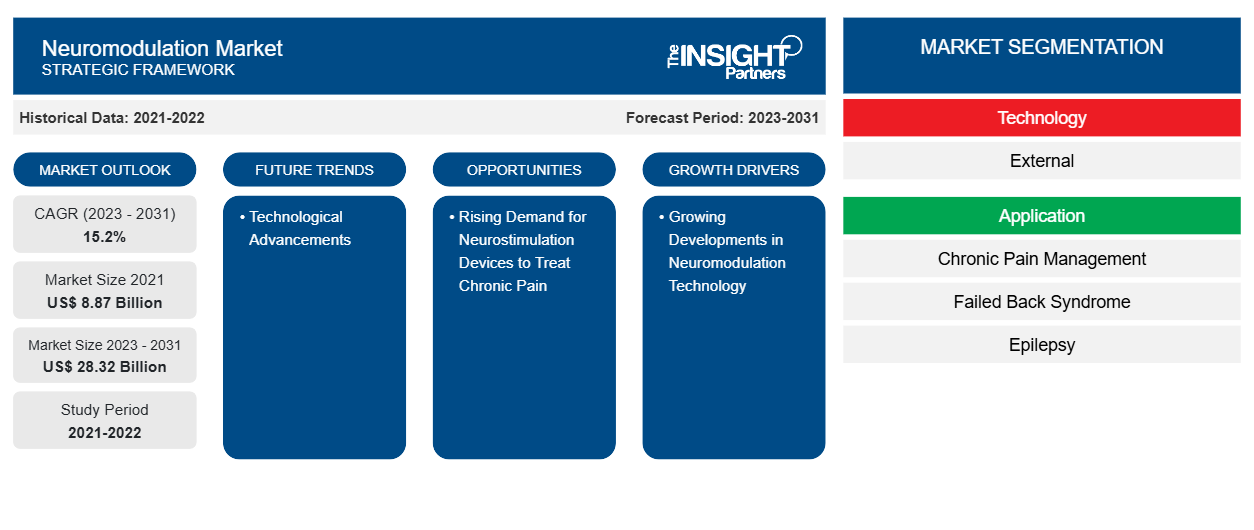Se estimó que el tamaño del mercado de neuromodulación sería de 8.870 millones de dólares en 2021 y de XX mil millones de dólares en 2023, y se espera que alcance los 28.320 millones de dólares en 2031; se estima que registrará una CAGR del 15,2 % entre 2023 y 2031. La creciente incidencia de trastornos neurológicos y los crecientes avances en la tecnología de neuromodulación son factores impulsores. Es probable que los avances tecnológicos sigan siendo tendencias clave en el mercado de la neuromodulación.Neuromodulation market size was estimated to be US$ 8.87 billion in 2021 and US$ XX billion in 2023 and is expected to reach US$ 28.32 billion by 2031; it is estimated to record a CAGR of 15.2% in 2023–2031. The increasing incidence of neurological disorders and growing developments in neuromodulation technology are driving factors. Technological advancements will likely remain key neuromodulation market trends.
Análisis del mercado de la neuromodulación
Los dispositivos de neuromodulación contienen pequeños electrodos en la médula espinal, el cerebro o los nervios periféricos. Los trastornos neurológicos como las enfermedades cerebrovasculares, la enfermedad de Parkinson y la enfermedad de Alzheimer afectan el funcionamiento neurológico del cuerpo y, por lo tanto, se pueden curar con la ayuda de la neuromodulación. Además, las empresas de dispositivos médicos están desarrollando cada vez más neuromodulación y están aumentando los programas de capacitación para tratar los trastornos neurológicos . Por ejemplo, en diciembre de 2023, el Centro de Investigación Avanzada y Excelencia en Neuromodulación lanzó un programa de capacitación sobre técnicas de neuromodulación en salud mental para profesionales médicos en el AIIMS.
Descripción general del mercado de neuromodulación
América del Norte es el mayor mercado de neuromodulación. El crecimiento se debe principalmente a la incidencia de enfermedades neurológicas como la enfermedad de Parkinson, la epilepsia, la enfermedad de Alzheimer y la depresión, entre otras. Por ejemplo, según los CDC, las personas que viven con la enfermedad de Alzheimer se duplican cada 5 años a partir de los 65 años y se espera que para 2060 esta cifra se triplique hasta alcanzar los 14 millones de personas. Entre todos los grupos étnicos, en comparación con los hombres, las mujeres tienen casi el doble de probabilidades de verse afectadas por la enfermedad de Alzheimer. Además, entre los estadounidenses de 65 años o más, el Alzheimer sigue siendo la quinta causa principal de muerte, por lo que las muertes por accidente cerebrovascular, enfermedades cardíacas y VIH han aumentado en más del 145% entre 2000 y 2019.
Personalice este informe según sus necesidades
Obtendrá personalización en cualquier informe, sin cargo, incluidas partes de este informe o análisis a nivel de país, paquete de datos de Excel, así como también grandes ofertas y descuentos para empresas emergentes y universidades.
-
Obtenga las principales tendencias clave del mercado de este informe.Esta muestra GRATUITA incluirá análisis de datos, desde tendencias del mercado hasta estimaciones y pronósticos.
Factores impulsores y oportunidades del mercado de la neuromodulación
Crecientes avances en la tecnología de neuromodulación
Los neuromoduladores alteran la actividad nerviosa al administrar con precisión agentes eléctricos o farmacéuticos en el sitio objetivo. Estos se utilizan repetidamente para aliviar el dolor crónico y el crecimiento tecnológico ha aumentado sus aplicaciones. Por ejemplo, en noviembre de 2022, CVRx lanzó un nuevo dispositivo de neuromodulación para tratar la insuficiencia cardíaca. Este dispositivo de neuromodulación trata los síntomas de la insuficiencia cardíaca, un nuevo generador de pulso implantable (IPG) Barostim NEO2. Esta segunda generación reduce el tamaño del IPG en un 10% y amplía la vida útil de la batería en un 20%, reduciendo así la frecuencia de reemplazo del dispositivo para los pacientes y sus proveedores. Además, en abril de 2021, Medtronic anunció la aprobación de la FDA para proceder con un ensayo de exención de dispositivo en investigación (IDE) para evaluar su dispositivo de neuromodulación tibial implantable (TNM) desarrollado internamente, una terapia destinada a aliviar los síntomas de la incontinencia de vejiga. alter nerve activity by precisely delivering electrical or pharmaceutical agents at the target site. These are repeatedly used for chronic pain relief and growing technological has increased its applications. For instance, in November 2022, CVRx launched a new neuromodulation device to treat heart failure. This neuromodulation device treats the symptoms of heart failure, a new Barostim NEO2 implantable pulse generator (IPG). This second-generation reduces the size of the IPG by 10% and widens battery life by 20%, thus reducing the device frequency replacements for patients and their providers. Furthermore, in April 2021, Medtronic announced the FDA approval to proceed with an investigational device exemption (IDE) trial to gauge its internally developed implantable tibial neuromodulation (TNM) device, a therapy intended to deliver relief from symptoms of bladder incontinence.
La creciente demanda de dispositivos de neuroestimulación para tratar el dolor crónico: una oportunidadNeurostimulation Devices to Treat Chronic Pain – An Opportunity
La demanda de dispositivos para el tratamiento del dolor está aumentando entre las personas mayores y las personas que padecen osteoporosis, artritis reumatoide y otras afecciones similares. Una investigación del NCBI afirma que en la India, casi 61 millones de personas padecen osteoporosis y, de ellas, el 80% son mujeres. La incidencia máxima de osteoporosis en la India se produce entre 10 y 20 años antes que en los países occidentales. Estas enfermedades exigen dispositivos de neuroestimulación para tratar el dolor.NCBI research states that in India, almost 61 million people have osteoporosis and out of these, 80% are women. The peak incidence of osteoporosis in India occurs 10–20 years earlier than in Western countries. Such diseases are demanding neurostimulation devices to treat pain.
Además, varias empresas emergentes están diseñando dispositivos con un enfoque principal en la terapia de neuroestimulación. Durante la terapia, estos dispositivos envían estimulación eléctrica a la médula espinal , los ganglios de la raíz dorsal y el cerebro que ayuda a relajar los músculos y reducir el dolor. Por lo tanto, las ventajas de la terapia de neuroestimulación han fomentado el desarrollo de productos mejorados en el mercado de la neuromodulación.neurostimulation therapy. During the therapy, these devices deliver electrical stimulation to the neurostimulation therapy have encouraged the development of enhanced products in the neuromodulation market.
La adopción de dispositivos de neuromodulación ha aumentado significativamente en varios países de América del Norte, Europa y Asia.
Análisis de segmentación del informe de mercado de neuromodulación
Los segmentos clave que contribuyeron a la derivación del análisis del mercado de neuromodulación son la tecnología, la aplicación y los canales de distribución.
- Según la tecnología, el mercado de la neuromodulación se divide en neuromodulación externa (no invasiva) y neuromodulación interna. La neuromodulación externa se subdivide en estimulación eléctrica respiratoria (RES), estimulación nerviosa eléctrica transcutánea (TENS) y estimulación magnética transcraneal (TMS). Además, el segmento de la neuromodulación interna también se subdivide en estimulación cerebral profunda (DBS), estimulación del nervio sacro (SNS), estimulación eléctrica gástrica (GES), estimulación de la médula espinal (SCS) y estimulación del nervio vago (VNS). El segmento de la neuromodulación interna tuvo una mayor participación de mercado en 2023.
- Según la aplicación, el mercado de la neuromodulación se divide en depresión, distonía, tratamiento del dolor crónico, síndrome de espalda fallida, enfermedad de Parkinson, epilepsia, temblor, incontinencia, gastroparesia, trastorno obsesivo-compulsivo (TOC) y migraña. El segmento de tratamiento del dolor crónico tuvo una mayor participación de mercado en 2023.
- En función del usuario final, el mercado de la neuromodulación se segmenta en hospitales, clínicas y atención médica domiciliaria. El segmento de hospitales tuvo una mayor participación de mercado en 2023.
Análisis de la cuota de mercado de la neuromodulación por geografía
El alcance geográfico del informe de mercado de neuromodulación se divide principalmente en cinco regiones: América del Norte, Asia Pacífico, Europa, Medio Oriente y África, y América del Sur / América del Sur y Central.
América del Norte ha dominado el mercado de la neuromodulación. El crecimiento del mercado se atribuye a los crecientes avances en el sector de los dispositivos médicos para la neuromodulación, a la creciente incidencia de trastornos neurológicos entre las personas y a la creciente demanda de dispositivos de neuromodulación para el tratamiento del dolor crónico. Además, la carga económica del tratamiento de los trastornos neurológicos está creciendo significativamente en el país. Se prevé que Asia Pacífico crezca con la tasa de crecimiento anual compuesta más alta en los próximos años.
Perspectivas regionales del mercado de neuromodulación
Los analistas de Insight Partners explicaron en detalle las tendencias y los factores regionales que influyen en el mercado de neuromodulación durante el período de pronóstico. Esta sección también analiza los segmentos y la geografía del mercado de neuromodulación en América del Norte, Europa, Asia Pacífico, Oriente Medio y África, y América del Sur y Central.

- Obtenga datos regionales específicos para el mercado de neuromodulación
Alcance del informe de mercado de neuromodulación
| Atributo del informe | Detalles |
|---|---|
| Tamaño del mercado en 2021 | US$ 8.87 mil millones |
| Tamaño del mercado en 2031 | US$ 28.32 mil millones |
| CAGR global (2023 - 2031) | 15,2% |
| Datos históricos | 2021-2022 |
| Período de pronóstico | 2023-2031 |
| Segmentos cubiertos |
Por tecnología
|
| Regiones y países cubiertos |
América del norte
|
| Líderes del mercado y perfiles de empresas clave |
|
Densidad de actores del mercado: comprensión de su impacto en la dinámica empresarial
El mercado de la neuromodulación está creciendo rápidamente, impulsado por la creciente demanda de los usuarios finales debido a factores como la evolución de las preferencias de los consumidores, los avances tecnológicos y una mayor conciencia de los beneficios del producto. A medida que aumenta la demanda, las empresas amplían sus ofertas, innovan para satisfacer las necesidades de los consumidores y aprovechan las tendencias emergentes, lo que impulsa aún más el crecimiento del mercado.
La densidad de actores del mercado se refiere a la distribución de las empresas o firmas que operan dentro de un mercado o industria en particular. Indica cuántos competidores (actores del mercado) están presentes en un espacio de mercado determinado en relación con su tamaño o valor total de mercado.
Las principales empresas que operan en el mercado de neuromodulación son:
- Abad,
- Corporación Científica de Boston,
- Medtronic,
- NeuroPace, Inc.,
- NeuroSigma, Inc.,
- CORPORACIÓN NEVRO,
Descargo de responsabilidad : Las empresas enumeradas anteriormente no están clasificadas en ningún orden particular.

- Obtenga una descripción general de los principales actores clave del mercado de neuromodulación
Noticias y desarrollos recientes del mercado de neuromodulación
El mercado de la neuromodulación se evalúa mediante la recopilación de datos cualitativos y cuantitativos de investigaciones primarias y secundarias, que incluyen publicaciones corporativas importantes, datos de asociaciones y bases de datos. A continuación, se incluye una lista de los avances en el mercado de la neuromodulación:
- La Administración de Alimentos y Medicamentos de los Estados Unidos (FDA) aprobó el sistema de estimulación de la médula espinal (SCS) Eterna de Abbott para el tratamiento del dolor crónico. Este dispositivo ofrece una experiencia mejorada con la capacidad de cargarse de forma inalámbrica tan solo cinco veces al año, la menor carga de recarga en comparación con otros sistemas de SCS recargables. (Fuente: Abbott / Nota de prensa, diciembre de 2022)
- GrayMatters Health, un desarrollador de terapias de neuromodulación digital para el cuidado de la salud mental, anunció el lanzamiento de Prism para el trastorno de estrés postraumático (TEPT) en los Estados Unidos. Prism para el TEPT es el primer dispositivo de neuromodulación automática que recibe la autorización de la Administración de Alimentos y Medicamentos de los Estados Unidos (FDA) como complemento prescrito al estándar de atención (SOC) para el TEPT y está disponible en dos clínicas de los Estados Unidos. (Fuente: GrayMatters Health, comunicado de prensa, enero de 2024)
Cobertura y resultados del informe sobre el mercado de neuromodulación
El informe “Tamaño y pronóstico del mercado de neuromodulación (2021-2031)” proporciona un análisis detallado del mercado que cubre las siguientes áreas:
- Tamaño del mercado y pronóstico a nivel global, regional y nacional para todos los segmentos clave del mercado cubiertos bajo el alcance
- Dinámica del mercado, como impulsores, restricciones y oportunidades clave
- Principales tendencias futuras
- Análisis detallado de las cinco fuerzas de Porter y PEST y FODA
- Análisis del mercado global y regional que cubre las tendencias clave del mercado, los principales actores, las regulaciones y los desarrollos recientes del mercado.
- Análisis del panorama de la industria y de la competencia que abarca la concentración del mercado, el análisis de mapas de calor, los actores destacados y los desarrollos recientes
- Perfiles detallados de empresas
- Análisis histórico (2 años), año base, pronóstico (7 años) con CAGR
- Análisis PEST y FODA
- Tamaño del mercado, valor/volumen: global, regional y nacional
- Industria y panorama competitivo
- Conjunto de datos de Excel
Informes recientes
Testimonios
Razón para comprar
- Toma de decisiones informada
- Comprensión de la dinámica del mercado
- Análisis competitivo
- Información sobre clientes
- Pronósticos del mercado
- Mitigación de riesgos
- Planificación estratégica
- Justificación de la inversión
- Identificación de mercados emergentes
- Mejora de las estrategias de marketing
- Impulso de la eficiencia operativa
- Alineación con las tendencias regulatorias























 Obtenga una muestra gratuita para - Mercado de neuromodulación
Obtenga una muestra gratuita para - Mercado de neuromodulación